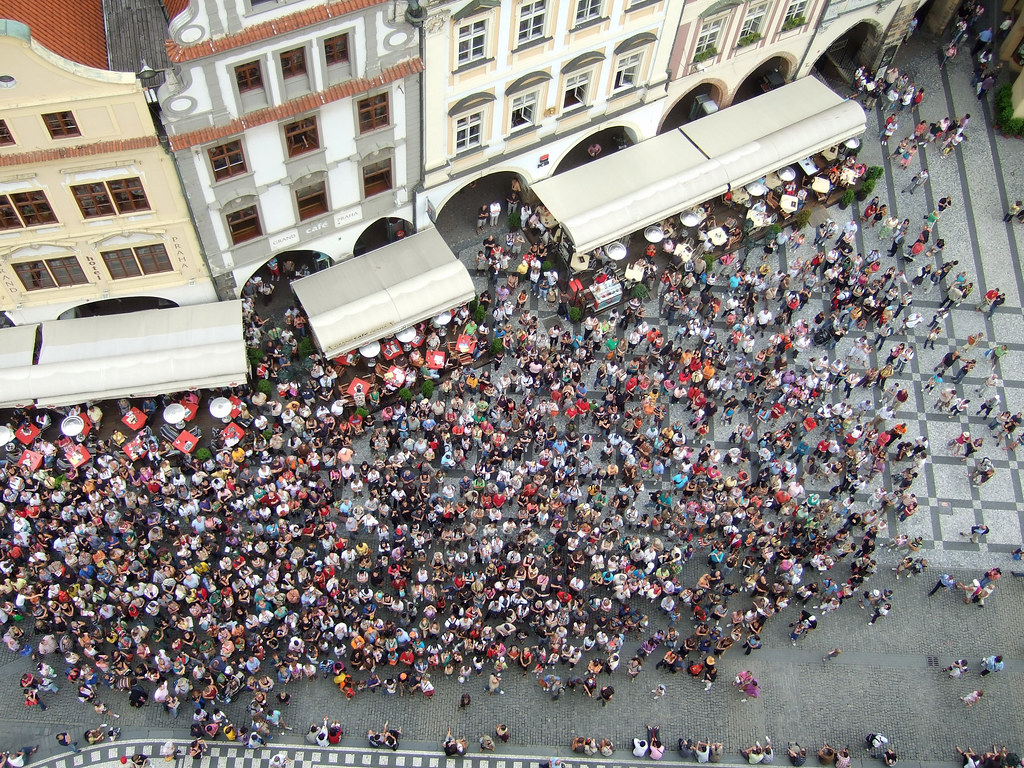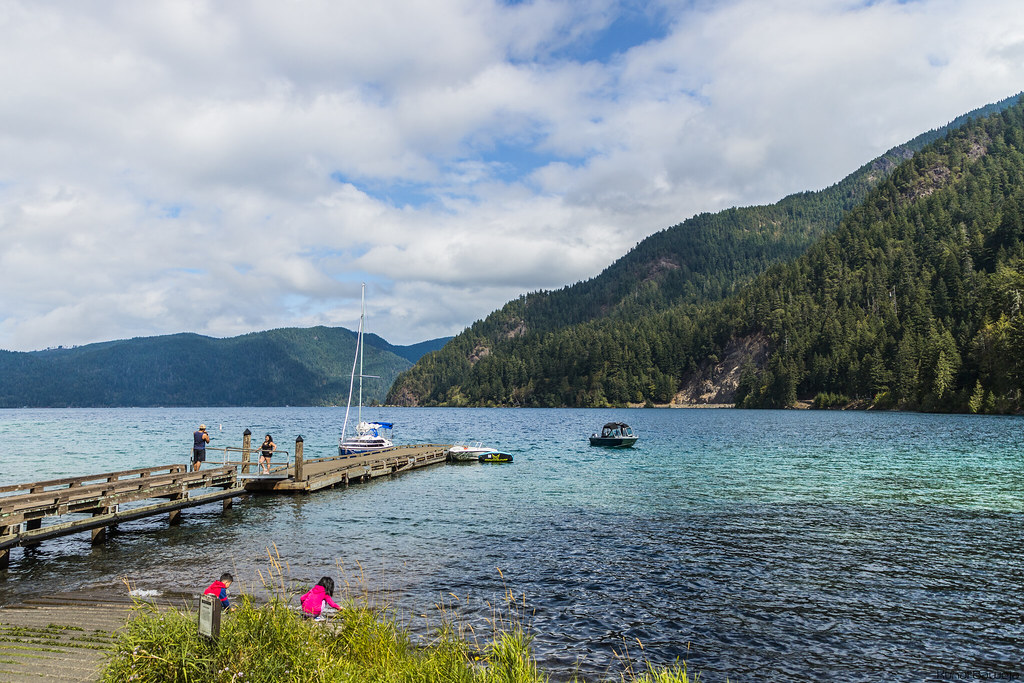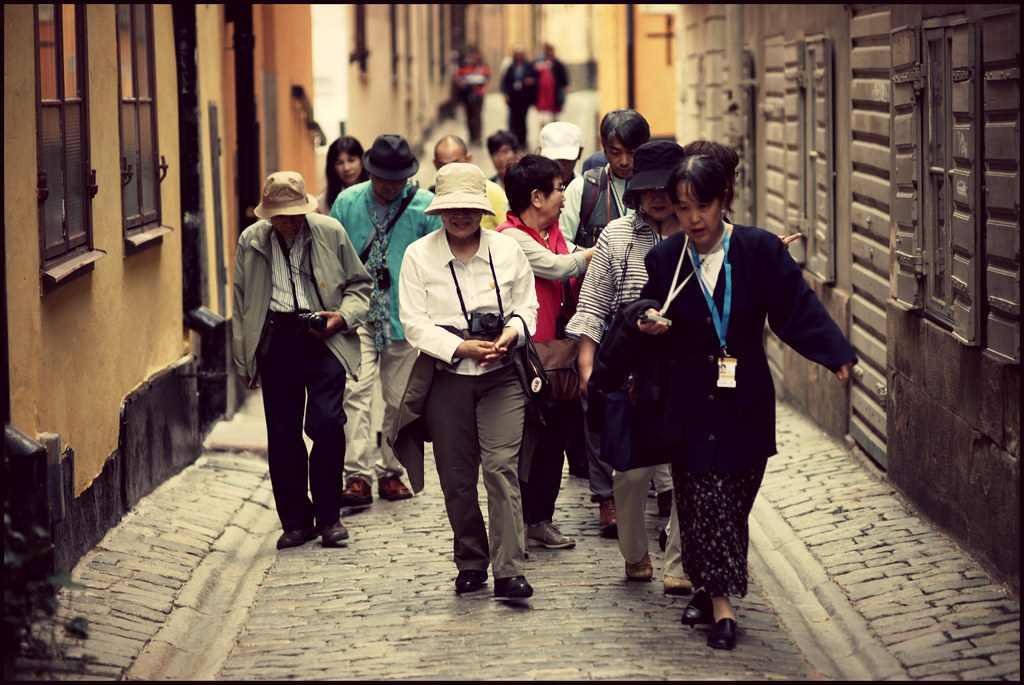Madhubala Ayyamperumal, Nick Backer, In Pun
Tourist Crowd in Venice. Flickr/Harald Groven.
What makes for a popular tourist destination? The most visited are often the ones that have been successfully mass-marketed through word of mouth, or, in recent years, the “buzz” of social media. Successful marketing strategies create a desire to quickly and cheaply see far-off locations. There is a problem with this type of marketing, however: Emphasis on a single aspect of a tourist location or one major building complex creates a false sense of culture. While singular “must-see” attractions are lauded, important cultural elements located nearby go unrecognized.
The problem is compounded when considering a tourist site’s local economic context. Lopsided marketing creates “hotspots” for tourists that move foot traffic from local businesses in a surrounding area to the marketed location. Concentrated marketing allows commercial attractions to dictate which building complexes are more valuable to the city and its culture. We argue that the uneven marketing can create major problems for a locale. Selective marketing means that market forces, rather than the people closely associated with the location, determine a tourist destination’s local economy. This happens as cash flows through a few highly marketable locations. As marketing leads to economic gain, the potential for such gain – and not other values such as cultural depth or local context – dictates what the most popular and lucrative attractions will be.
The focus on profit creates an interesting dilemma: as tourism increases in “hotspot” locations, the location becomes more reliant on tourism money and has to cater more and more to the demands of the visiting population. This is turn leads in a downward spiral to compromised cultural identity and, in some cases, economic vulnerability as other sources of economic activity dry up.
As designers of the built environment, and purveyors of how it is marketed and used, we see an ethical imperative in maintaining a site’s accurate cultural portrayal and the economic wellbeing of its residents.
Venice: Excessive Tourist Marketing Hurts Local Economy
Tourism has become a worldwide industry, with much of the industry focused on profit, rather than on local sustainability. Venice has become a prime example of this trend. The city has advertised itself as a tourist destination for centuries, and for a time thrived on its influx of tourists as a form of cultural exchange. Jeremy Black, author of Italy and the Grand Tour, points out that, “In so far as broad trends can be discerned in the tension between xenophobia and cosmopolitanism [….] as facilities for tourists developed, so they became less alien figures to the Italians…”.
As of the 21st century, however, Venice is groaning under the weight of constant tourism. The city’s photogenic appeal attracts so many travelers that on a given day there are more visitors than residents. The vast majority of tourists do not stay overnight in Venice, but are day-trippers. The short-term tourists spend their money and time in the areas of the city that cater to and are most marketed for the tourist. Two main attractions especially are highlighted as the top spots to visit in Venice, St. Marks Basilica and the Doges Palace. The focus on these two buildings leads gigantic human waves to arrive into the city and flow back and forth between the two landmarks, creating a makeshift commercial channel frequented by tourists.
The result has been predictable: As a local travel writer laments, “Small businesses and artisans’ craft shops have been replaced by identical souvenir stalls and fast food restaurants to cater to day-tripping bargain hunters”. Two landmarks within walking distance of each other have impacts that are felt city wide. Coupled with this is the fact that the Venetian population continually decreases every year as the influx of tourism has destabilized its local economy, bringing with it an increase in the cost of living, a decrease in the quality of life, and a lack of spaces for youth. Venezia Autentica, an organization dedicated to the preservation and sustainability of Venice, notes that, “The daily saturation of the city leads to an overwhelming invasion of cheap, imported souvenirs and tourist traps which are destroying local businesses and artisans’ shops as they cause an increase in the cost of living and renting. The consequences of this are a decrease of life quality and opportunities for the locals…”.
Tourist activities in Piazza San Marco, Venice, Italy. WikiCommons/Rolf Benedikt.
Much of the increase in day-tripper tourism is due to large cruise liners who market Venice as one of the top three destinations in the world. The cruise ships make port in Marghera, Venice and from there passengers are led from the port through the crowded avenue between landmarks, passing by souvenir shops along the way.
It is unclear whether or not Venice will be able to recover from its tourist problem, since tourist marketing has set in progress changes to the local economy to the point that tourism is Venice’s major source of revenue. But at what cost? Carlo Beltrame, a researcher in humanities at Venice’s Ca’Foscari University, sums up the voice of his compatriots: “It feels as if we’re at a point of no return because it’s already out of control.” He proposes reducing tourist numbers while focusing on new methods to steer Venice’s economy away from its dependence on tourism. To improve the quality of life in the city, he has suggested establishing it as a hub for scientific and maritime research.
Goa, India: Excessive Marketing Harms Cultural Identity
Lake Crescent, Goa, India. Flickr/ Kunal Baweja.
The territory of Goa on India’s West Coast is known for its beautiful beaches and coastline. The topography consists of the Western Ghats, smaller hills in the central part, and low lands along the coast. Goa was ruled by the Portuguese until 1961, when it became a part of the Indian Republic. The cultural heritage of Goa is heterogeneous due to interventions from various dynasties, and is enriched by several different civilization streams.
Despite Goa’s rich cultural history, tourism marketing focuses largely on its recreational aspects: sun, sea and sand. This limited focus sidesteps the rich cultural heritage that the destination has to offer: renowned forts, classic churches, varying types of temples and mosques; and picturesque colonial architecture. For example, the gleaming whitewashed churches with Portuguese-style facades set Goa apart from the rest of the sub-continent. Such features are, however, not marketed as readily as the beaches and cheap liquor that are highlighted in marketing campaigns.
Large, western-style hotels and resorts have become enclaves set into the local environment yet completely oblivious to it . For example, the main feature of a Goan house is the ‘balcao’; a type of porch where residents sit to pass the time, greet neighbors as they pass, and in turn, be acknowledged. It promotes “communitas”, the spirit of community. “Communitas” is an important cultural concept in Goa. Smaller, family run hotels that offer a more holistic experience of Goa have retained this cultural concept. However, the marketing efforts by larger hotels often create a false representation of this experience. The result is that most tourists experiences fall short of the authenticity of the local culture and customs.
Many of Goa’s cultural traditions have been commercialized through marketing. For example, the Goa Carnival was originally introduced into the culture by the Portuguese, yet shares characteristics with the Hindu festival of Holi, the festival of colors. The carnival lost its spontaneous atmosphere as marketing agencies targeted its tourism potential. Overnight, the festival became a “‘big show” with sponsored floats, live bands, and cardboard cut-outs of sponsored products.
Tourism and one-sided marketing has impacted the socio-cultural identity of Goa. It has commercialized traditions as it has allowed artificial versions of Goa’s culture to flourish. Excessive commercialization has led to a loss of identity and the destruction of heritage sites in the name of tourist development and “beautification”. Local residents are now denied access to certain beaches. Tourism has brought a feeling of estrangement to a large number of Goa’s residents.
Mass tourism in a historic setting. Flickr/ *Kicki*
Conclusion
While on the surface tourism seems like an economic opportunity for a site, mass marketing of popular sites can lead visitors to overlook a destination’s deeper cultural treasures and traditions. In both the Venice and the Goa examples, marketing has been concentrated on a few local, popular aspects that are easily taken in. This has caused not only shifts in a site’s cultural perception, it has also altered the local economy to accommodate the needs of mass tourism. Local residents have seen their cultural traditions diluted as their economy becomes vulnerable through its singular focus on mass tourism. While tourism has always been a popular way to experience other cultures and civilizations, an ethical approach demands that tourism should not work against the interests of local citizens or contribute to a destination’s cultural and economic downturn.
References
Black, Jeremy. Italy and the Grand Tour. New Haven, CT: Yale University Press, 2003. https://books.google.com/books?id=RPUCjv1u4qYC&printsec=frontcover&source=gbs_ge_summary_r&cad=0#v=onepage&q&f=false
Chase, Gregory and Ilan Alon. 2002. “Evaluating the Economic Impact of Cruise Tourism: A Case Study of Barbados.” Anatolia 13 (1): 5-18. https://doi.org/10.1080/13032917.2002.9687011.
Edwards, Catherine. 2017. “Tourism is Killing Venice, but it’s also the Only Key to Survival.” The Local. https://www.thelocal.it/20170718/mass-tourism-killing-crowded-venice-survival-authentic-travel-local.
Falleiro, Savio P. 2015. “Economic and Socio-cultural Balance Sheet of Tourism in Goa: Future Options” International Journal of Scientific and Research Publications, Volume 5, Issue 2, February 2015. http://www.ijsrp.org/research-paper-0215/ijsrp-p3815.pdf
Giuffrida, Angela. 2017. “‘Imagine Living with this Crap’: Tempers in Venice Boil Over in Tourist High Season.” The Guardian, July 22, 2017. https://www.theguardian.com/world/2017/jul/23/venice-tempers-boil-over-tourist-high-season.
Menon, A.G. Krishna. 1993. “Case Study on the effects of tourism on Culture and Environment – India (Jaisalmer, Khajuraho and Goa)” UNESCO Principal Regional Office for Asia and the Pacific, Bangkok, 1993. http://unesdoc.unesco.org/images/0012/001216/121600eo.pdf
Meyer, Dorothea. 2004. Tourism Routes and Gateways: Key Issues for the Development of Tourism Routes and Gateways and their Potential for Pro-Poor Tourism. London, UK: Overseas Development Institute. https://www.odi.org/sites/odi.org.uk/files/odi-assets/publications-opinion-files/4040.pdf.
Stokes, Robyn. 2008. “Tourism Strategy Making: Insights to the Events Tourism Domain.” Science Direct 29 (2). https://ac.els-cdn.com/S0261517707000763/1-s2.0-S0261517707000763-main.pdf?_tid=049c2891-19d2-4ac1-ac59-4930e0156d3f&acdnat=1544541676_dc0b4ad0543d7f0d702388b48feb6928.
Venezia Autentica. 2018. The Current State of Tourism Us Hurting Venice. Impact. Venice, Italy: Venezia Autentica S.R.L.S. https://veneziaautentica.com/impact-tourism-venice/.




0 Comments